The 12 British Shorthair Cat Colors & Patterns Explained
This page contains affiliate links. We may earn money or products from the companies mentioned in this post through our independently chosen links, which earn us a commission.
The British shorthair cat makes the perfect snuggle buddy. This feline who looks very much like a teddy bear is loved by many cat parents.
The name of the British shorthair is a perfect description of what you can expect from this feline. British Shorthair cats have thick, silky and short coats. These kitties also have a no-nonsense but easygoing and calm attitude towards life which is why they make such wonderful family pets.
The British shorthair distinct dense coat comes in a variety of colors and patterns. The classic British blue kitty that has a solid blue-grey coat color is probably the most popular among British Shorthair lovers.
But other cute felines do exist too. For instance, the stunning chocolate British shorthair furball has a beautiful chocolate coat. Other cute British Shorthair coat colors include, fawn, cinnamon, ginger, black, smoke, and lilac as detailed below.
1. Blue Color
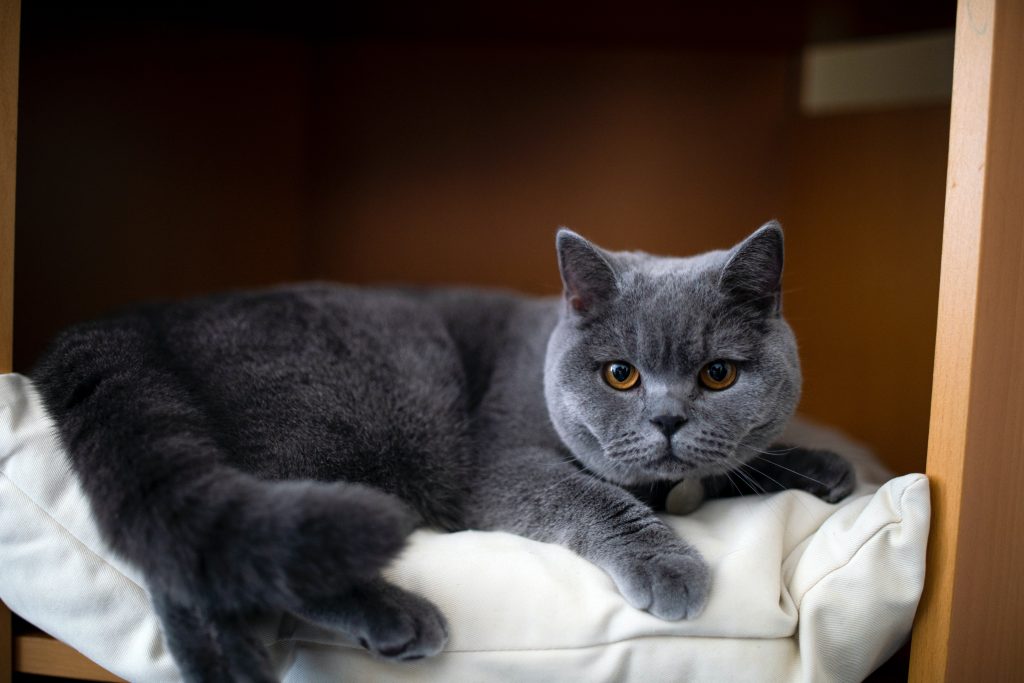
It’s the oldest and the most common color among British shorthair cats. British blue cats have a dense coat of light to medium blue-gray color without any spots, stripes, white hair, or patterns. The undercoat has a slightly lighter color than the coat.
A kitten born with this classic coat color may have some stripes which will disappear with age. The blue-colored British Shorthair has bright golden, orange, or copper eyes and a blue nose and paw pads.
2. Chocolate Color
The coat tone of the Chocolate British shorthair cat is also called Havana or chestnut. This breed gets its chocolate coloration due to cross-breeding it with chocolate Persian cats.
The Chocolate British shorthair cat has a rich and deep chocolate color and the darker the coat color, the better. By breed standards, white hair(s) or other colors on the chocolate coat aren’t accepted while all shades of chocolate from light milk chocolate to dark chocolate are accepted.
It takes 1-1.5 years for the full formation of this coat color for this cat. Chocolate-colored British Shorthair Cats have dark orange or copper eyes and cats with more saturated eye color are more valued. The Chocolate British shorthair toe pads and nose tips are either pink or chocolate.
3. Cream Color
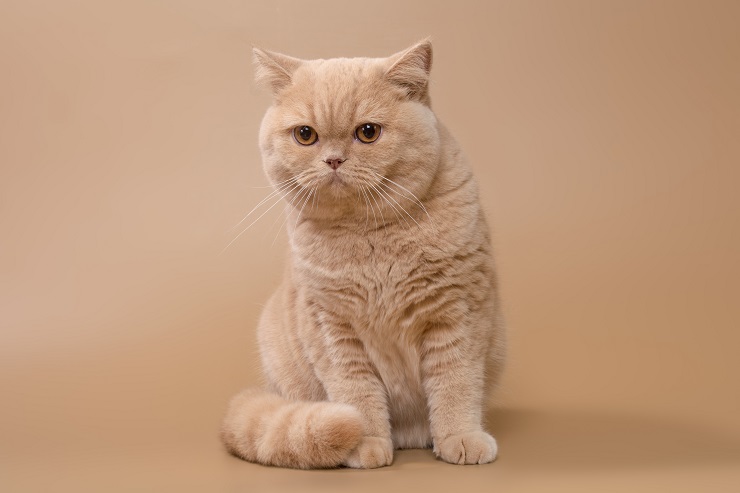
This coat color belongs to the oldest types of British Shorthair solid colors. Cream-colored British shorthair cats have light red coats which appear cream when the dilute white gene is present.
This cat has a soft, pastel shaded coat with an off-white hue that’s neither dark as fawn nor ruddy as red. Cream-colored British shorthair cats have pink paw pads and noses. The cats eyes are either orange, copper, or golden.
4. Lilac Color
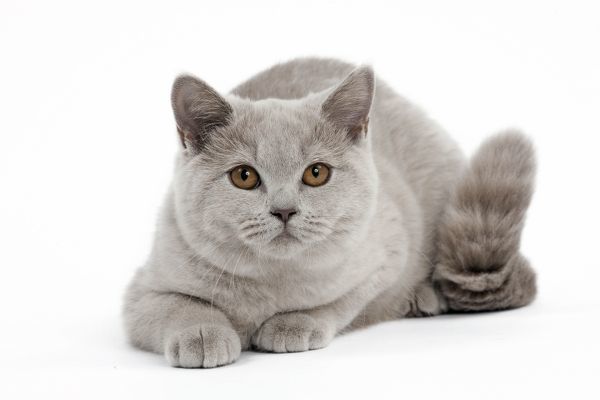
This is a common color among the British shorthair cats. Lilac British Shorthair cats have a combination of pink, gray, and blue colors on their coats. The coat colors come in different variations from cold lavender to warm pink-gray.
The paw pads and nose of the Lilac British Shorthair corresponds with the coat tone. This feline’s undercoat color is slightly lighter than the outer coat. This cat has bright orange-copper or amber eyes and a pink mauve shade on its paws, nose, and eyes contours which darken over time.
5. White Color
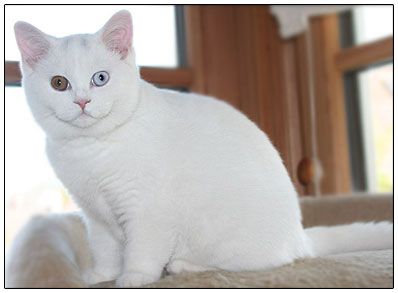
This is a pure, snow-white cat breed without any spots, stripes, smoky or yellow undertones.
This gorgeous British shorthair cat has a pink nose and toe pads with sapphire blue, orange, or yellow eyes. It’s difficult to breed this cat because there is a high likelihood of getting a breed with health issues such as deafness.
6. Red (Ginger) Color
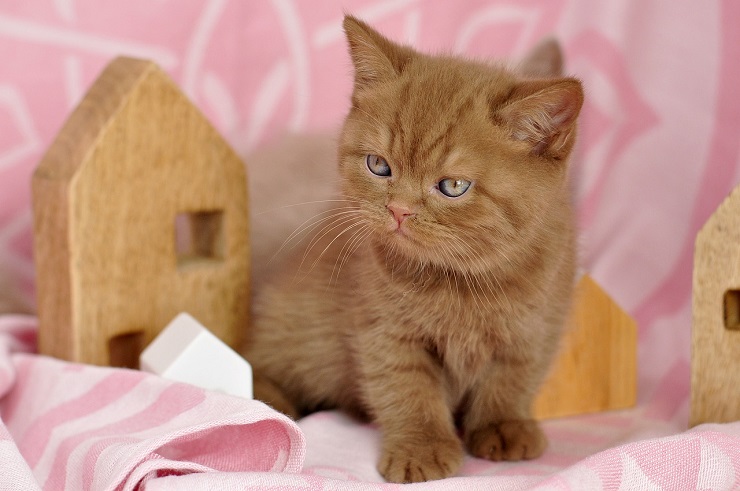
The Red/ginger British Shorthair is also known as Garfield. This cat inherits its red gene from Persian cats and other exotic cat breeds with red coats.
The red color on the cat’s coat is not solid but it’s unevenly distributed. Your red British Shorthair will have tabby markings on its forehead and paws. This cat also has copper or orange eyes and a brick red tone on its nose and paw pads.
7. Black Color
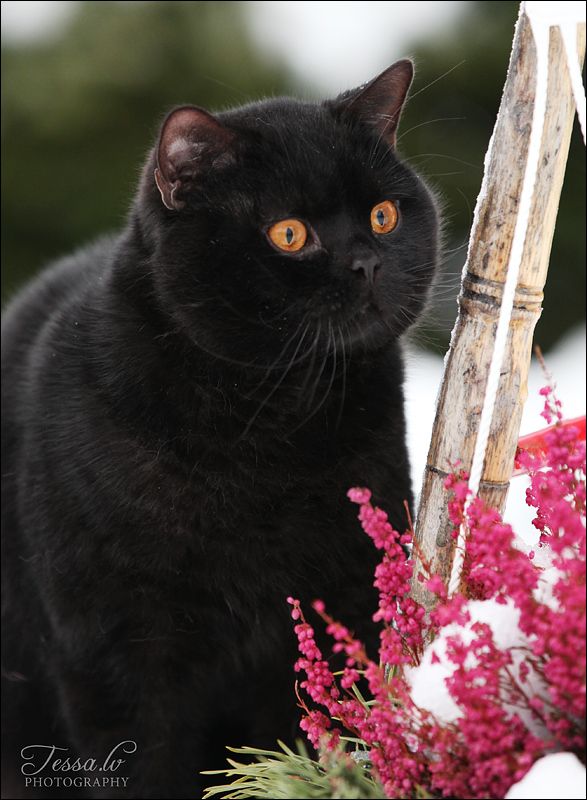
The black colour among the British Shorthair cats is a rare color that’s difficult to breed. This cat will have a pure jet black coat without rusty shades or brown patches.
Both the nose and paw pads of this cat are black. The coat, undercoat, and skin pigments are saturated. Black British shorthair orange eyes match perfectly with the cat’s deep black hair.
8. Cinnamon Color
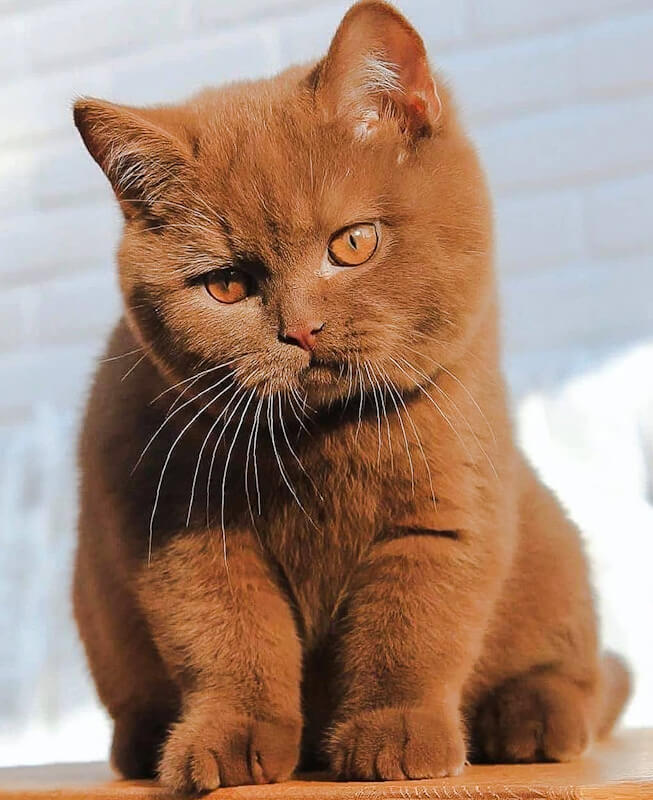
This is a rare cat that is highly valued among the British shorthair cat lovers. It’s similar to the diluted chocolate-colored cat but its coat has a warm and soft chocolate color with a copper or reddish-brown undertone.
A cat with a light brown or milk chocolate color is not considered a cinnamon-colored cat. Cinnamon-colored British Shorthair cats have orange or bright amber eyes and pink or cinnamon toe pads and nose tips.
9. Fawn Color
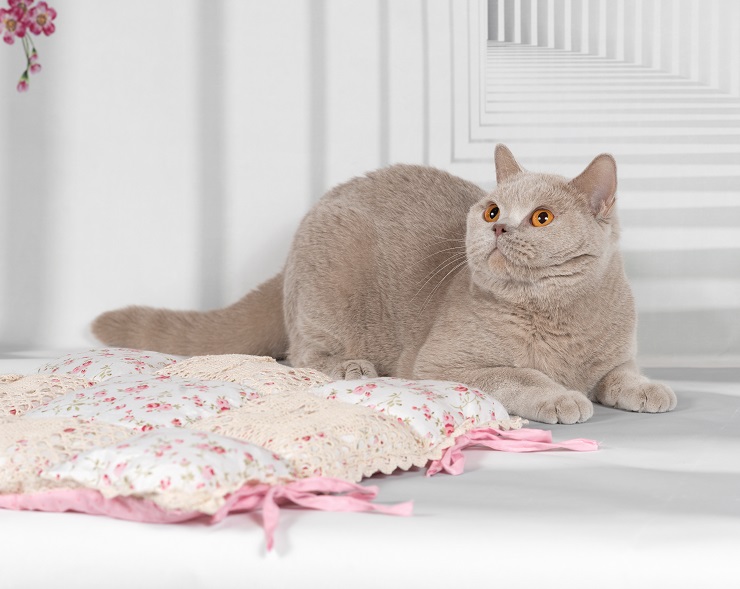
The fawn colored British Shorthair is an extremely rare and exotic breed that is highly valuable. This cat has a soft, elegant, and beautiful mushroom-colored coat with a rosy hue. Its coat has a diluted cinnamon color that looks like burnt cinnamon.
Fawn-colored British shorthair cats have small noses and paws pad that are pink. A fawn British Shorthair cat breed is born if both parents are fawn gene carriers. The fawn color gene is confirmed only by a DNA test. Cat species with similar unconfirmed colors are termed cream, blue, or rejected.
10. Tortie or Tortoiseshell Color
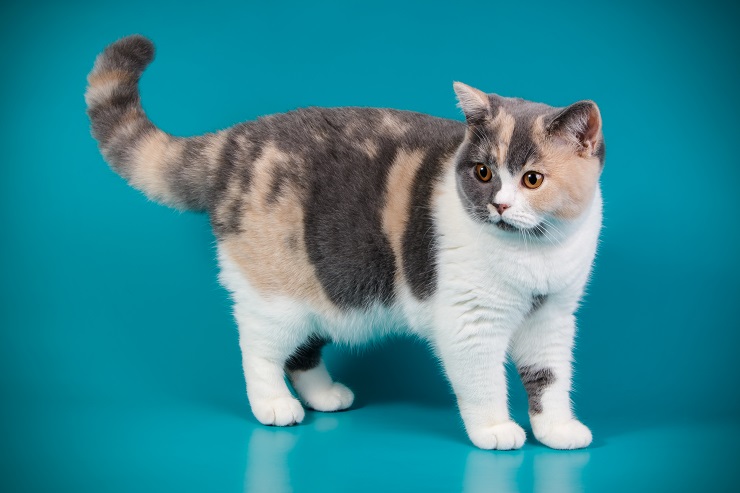
The Tortie British Shorthair cat breed has orange, amber, or copper eyes. This cat has a combination of tabby patterns with spots of solid shades leaving a mosaic pattern on its coat. A tortoiseshell color pattern takes time to fully develop and often this cat is born with few color spots which increases with age. Tortoiseshell British Shorthair cats are named kings and queens since they can produce offspring of various colors including:
- Black Tortie– It’s a combination of proportional red and black colour shades with different specks. The black color is saturated while the red is bright and intense. The Black Tortie coat is evenly colored. Its head and paws have both red and blue colors
- Chocolate Tortie– It’s a combination of chocolate and red colors in identical proportions. The chocolate color is saturated while the red is bright and intense. Chocolate Tortie has red and chocolate tones on its muzzle and paws.
- Blue Tortie– It has a proportional combination of blue color and cream spotted patterns. Blue Tortie cat has an overall coat tone of light cream or medium blue. It may also have a cream nose.
- Cinnamon Tortie– This is a combination of red shades and spots of cinnamon in equal proportions. This color is very soft and warm yet saturated. A Cinnamon Tortie nose and paw pads are red. This breed is very rare and highly valued.
- Lilac Tortie- This British Shorthair has a combination of lilac and cream colors in uniform proportions. The Lilac Tortie cats may also have red and lilac colors clearly and evenly spread on their coats without any spots, marbles, stripes, or white hair(s).
- Fawn Tortie– This is a very soft and light combination of fawn and cream spots. This species is very rare. Fawn Tortie has cream paw pads and a nose.
- Smoke Torie Colors– It’s a combination of classic tortie colours with smoke. This cat’s undercoat is lightly colored with silver hair at the roots. This British Shorthair will haves pink, black, cream, blue, or brown nose and toe pads
- Torbie colors– This cat’s coat will have a combination of classic tortie color with tabby pattern presented by stripes, spots, or marble markings. Tortie colors come in different variations and color points including bi-color or calico, tri-color or tortie with white.
11. Tabby Color
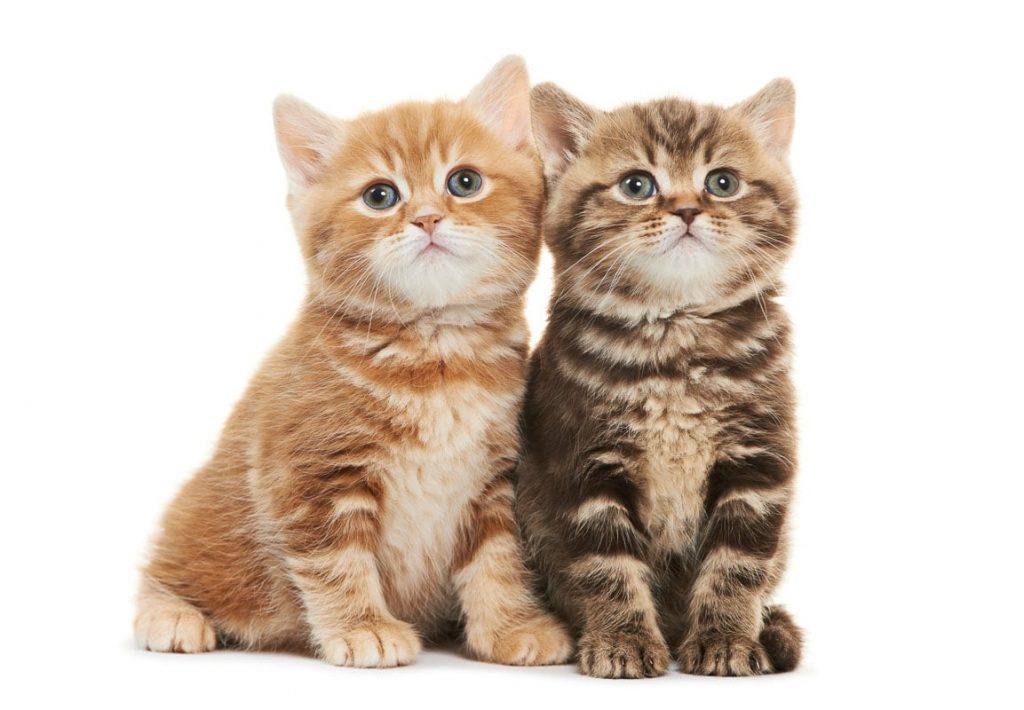
This British Shorthair breed has an ‘M’ marking on its forehead. Its coat has clear and dense color markings and it’s not brindled. This cat has no white hair or markings on its coat, chin or lips. The ears have the same color stripes makings as that of its coat. The cat’s tail and paws have numerous narrow ring-shaped markings.
This feline also has spotted markings on its toes and belly. Tabby British shorthair cats fall into classic tabby, mackerel tabby, and spotted tabby categories:
- Classic tabby– This beautiful cat has butterfly markings on its shoulders and complete tail rings. This tabby also features a line from the butterfly markings down to its back and tail.
- Mackerel tabby- This breed is characterized by many narrow stripes. It has continuous or broken ring-shaped strips on its tail
- Spotted tabby– This cat’s legs have spotted patterns. It has the same head marking as the classic and mackerel tabbies. This feline also has dark spot markings on its coat
12. Solid Color
This color is monochrome and is distributed evenly throughout your British Shorthair’s entire coat without any stripes, spots, patterns, or white hair(s).
The classic solid colors of the British Shorthair are lilac and blue while black, chocolate, and cream are not very common. Cinnamon, red, and fawn are the rarest and genetically interesting solid colors of the British Shorthair.


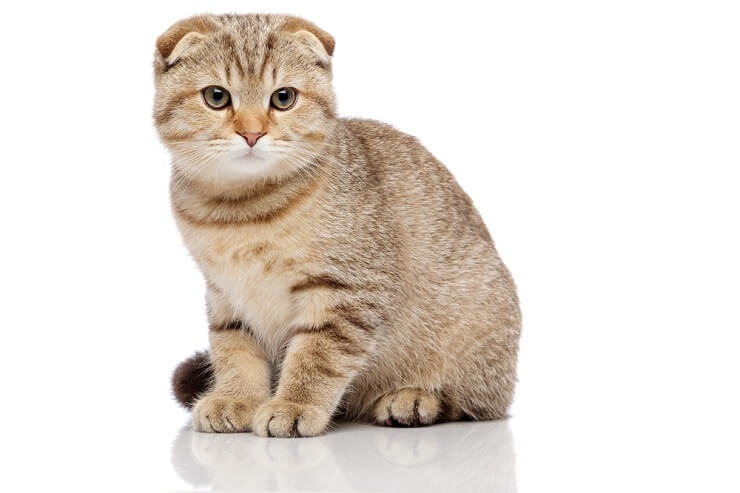
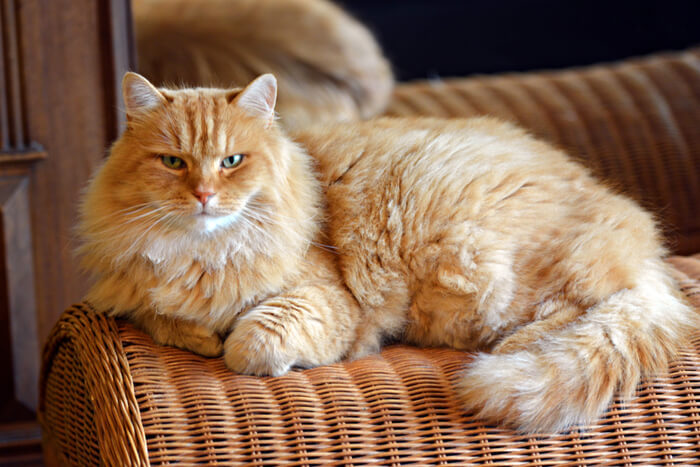
Mike
Hi Agnes, question. is it normal to a Blue British Shorthair has tiny white hair strands in some areas of the body?
[email protected]
Hi Mike, We have seen Blue British Shorthairs that have white strands on different areas of their body from time to time. It's quite normal:)
Lyn
I would like to find a home for a sweet beautiful blue torte that seems to be without a family. [email protected]
Red
What about silver coloured British Shorthair?
Adnan
Amazing breed, especially the black one. Would love to pet one.
Shaun S
Very useful and good information. Love it!!!
Shaun S
Hi Agnes, I have a BSH Tabby kittens but unsure of their colours. They are so adorable and always make my day. Is there anyway you could assist me with their colour coat. Thank you!!
Susan
A very late reply but i just read this. The white longer hairs are what i call body whiskers. They literally are the same type of feelers as his whiskers and what they have above their eyes. if you touch those you will see their skin "crawl" sometimes. Just for the ppl who are wondering also reading this :p
Samirah
Hi Agnes. What category does the Golden British Shorthair fall into? Is it considered an orange cat?
Jenny Turley
Hi Agnes, I have two Black golden females who are registered. I know they're not recognised as a colour by the FIFe, but was wondering why they've not been mentioned in this article?